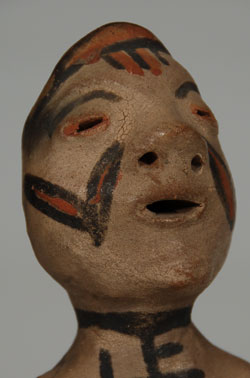Tesuque Pueblo Turn-of-the-century Rain God Figurine [SOLD]
+ Add to my watchlist Forward to Friend
- Category: Figurines
- Origin: Tesuque Pueblo, TET-SUGEH
- Medium: native clay, pigments
- Size: 6-1/2” tall
- Item # 25569 SOLD
 Louis Gold, a Polish immigrant who settled in Santa Fe in the mid-1800s, was joined by his sons a few years later and they are the primary ones to foster the curio trade in Santa Fe. Jake and Aaron Gold set up shop on San Francisco Street at Burro Alley in downtown Santa Fe. Jake Gold eventually took over operations of the store from his brother Aaron and continued operating it until the end of the century. It became a famous store in Santa Fe for locals and tourists interested in Indian curio items. Later, Gold partnered with J. S. Candelario to open another curio shop. Gold once stated he had eight Mexicans and eight Indians visiting the reservations collecting for him.
Louis Gold, a Polish immigrant who settled in Santa Fe in the mid-1800s, was joined by his sons a few years later and they are the primary ones to foster the curio trade in Santa Fe. Jake and Aaron Gold set up shop on San Francisco Street at Burro Alley in downtown Santa Fe. Jake Gold eventually took over operations of the store from his brother Aaron and continued operating it until the end of the century. It became a famous store in Santa Fe for locals and tourists interested in Indian curio items. Later, Gold partnered with J. S. Candelario to open another curio shop. Gold once stated he had eight Mexicans and eight Indians visiting the reservations collecting for him.
Jonathan Batkin, in "The Native American Curio Trade in New Mexico" stated that the only way for Gold to have sufficient merchandise was for him to develop some type of artifact and have the Pueblo Indians provide it in quantity. The most famous item of this category that Gold had a hand in was the development of the Tesuque rain god figurine, an item for which he was paying 5 cents each.
Gold both wholesaled and retailed rain god figurines. On a typical year, he retailed over 100 of them from the store and shipped them in barrels of 100 to a barrel for wholesale customers for $6.50 per barrel. By 1907, he was shipping over 1000 rain gods annually. The sales continued for years, although at a lesser quantity during the depression years.
The intrigue and interest of rain god figurines continues today. This one is typical of the turn of the century ones. It is beautifully decorated with warrior marks on the cheeks, painted hair and eyebrows and a typical necklace of the period with a whirling log pendant. The pot in the lap of the figurine is decorated at the rim and around the neck. It is likely that this one pre-dates 1900 by a few years.
Condition: the figurine had a broken right arm at the shoulder, broken left arm at the wrist and both legs broken at the ankles. All have been glued back in place very well.
Provenance: from a Santa Fe collector
Recommended Reading: The Native American Curio Trade in New Mexico by Jonathan Batkin
- Category: Figurines
- Origin: Tesuque Pueblo, TET-SUGEH
- Medium: native clay, pigments
- Size: 6-1/2” tall
- Item # 25569 SOLD



